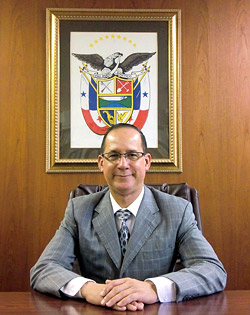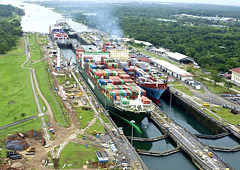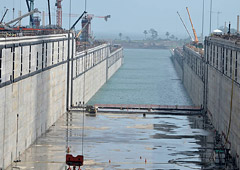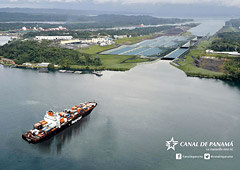Ocean Newsletter
No.365 October 20, 2015
-
Panama Canal: Moving towards completion and opening of new business opportunities
Ritter DIAZ Ambassador Extraordinary and Plenipotentiary of the Embassy of the Republic of Panama in Japan
In order to mark the 100th anniversary of its opening as well as to meet the needs of a new era, the Panama Canal is in the final stages of constructing new locks and expanding the width of the canal to allow the passage of much larger ships. The new canal will also make possible the shipping of LNG. Panama is working hard to provide the maritime services necessary to meet the energy demands of Japan and other Asian countries.
-
A New Challenge by the City of Himi, a Leader in Fishing Village Culture ~Creating Community Development through the Himi Fishery Network Gallery: Totoza~
Yujiro HONGAWA Mayor, City of Himi, Toyama Prefecture / Selected Papers No.20(p.18)
Located at the base of the Noto Peninsula, Himi City faces Toyama Bay and has inherited a long history of fishing village culture. The newly opened Himi Fishery Network Gallery "Totoza" is a community center that aims to pass on fishing village culture, such as the now world-famous Etchu-style fixed net techniques, as well as bring attention to Himi's unseen social capital and the ties among local residents.
Selected Papers No.20(p.18) -
On Marine Sports and Weather Forecasting
Michio KATO President, Surflegend Inc.
Anyone who has been involved with marine sports over a long period of time has undoubtedly, more than once, been affected by sudden changes in weather that resulted in a completely unexpected, and frightening experience. Using the latest marine weather forecasting technology, we aim to prevent accidents from happening by turning "unexpected" events into "expected" ones. In order to increase safety and the "peace of mind" aspects of marine sports, I would like to introduce applications of pinpoint ocean forecasting, with the ambition that it leads to advancement, no matter how small, in the development of healthy marine sports.
Panama Canal: Moving towards completion and opening of new business opportunities
 H.E. Mr. Ritter Diaz, Ambassador Extraordinary and
H.E. Mr. Ritter Diaz, Ambassador Extraordinary and
Plenipotentiary of the Embassy of the Republic of Panama in Japan
Last year, the Panama Canal celebrated its 100 years of successful operation and is preparing for a new phase with the completion of new expanded locks, which will allow for the passage of larger ships.
 Gutun Locks(Embassy of Panama in Japan)
Gutun Locks(Embassy of Panama in Japan)
In this regard, last June, both locks on the Pacific and Atlantic sides were filled with water and in July the contractor started testing the opening and closing of the sliding gates.
In the coming months, the Panama Canal pilots will start the training to pass the Neopanamax vessels through the wider locks as the new system will use tugboats to move the ships, instead of the four locomotives used by the current Canal to pull the vessel through the locks.
As informed by the Panama Canal Authority (PCA), the construction work should be finalized by the end of December this year and full operation is scheduled to begin in April 2016, when the new tolls will also be applied for traffic through the new locks.
 Flooding of one of new locks of the Panama Canal (The Panama Canal Authority [PCA])
Flooding of one of new locks of the Panama Canal (The Panama Canal Authority [PCA])
As for the new tolls, the PCA has already approved the new structure after consultation with different stakeholders, including Japanese shipowners, and depending on the market segment there are incentives offered by the PCA to encourage use of the waterway. Incentives include a program of loyalty for container ships, differentiated tolls based on the merchandise type for the dry bulk carriers, preferential tolls for return trips of LNG tankers, and tolls based on the percentage of utilization of ships for the segment of car carriers.
Understanding that the shipping industry is as cost-sensitive as any industry, the PCA is developing new services around the Canal such as energy generation, bunkering, ship repair, container and LNG terminals, with the purpose of generating other sources of revenue and not rely only on regular toll increases, as it is well aware of other competitive routes.
In this connection, the PCA is working on a project to build container terminals in the area of Corozal, on the Pacific side of the Canal. If realized, these container terminals would be able to handle around 5 million containers a year, increasing Panama’s container movement capacity up to 11 million containers per year.
In addition, after the new locks enter into operation, the Panama Canal is expected to handle significant LNG tanker traffic. Thus, in order to capitalize on this growth, the administration of the waterway has partnered with the United States Trade and Development Agency (USTDA) to carry out a feasibility study to develop a liquefied natural gas (LNG) import terminal.
The study will help the PCA set strategic priorities and plan projects related to LNG infrastructure and natural gas utilization at the Panama Canal. We believe that the establishment of an LNG terminal will support the further implementation of maritime-and-energy projects that will accommodate increased shipping traffic through the expanded Canal.
The expansion has also had a great impact on the modernization of ports in the US and the Latin America and Caribbean countries, as these countries need to accommodate the Neopanamax ships, which require deeper draft and larger container yards and cranes to unload their cargo at the port facilities. So, the benefits of the Canal expansion are going well beyond the borders of our country.
The PCA is also well aware of the high expectation of the Japanese government for the opening of the new locks to star the shipping of LNG from the Gulf of Mexico to Japan and other countries of Asia to satisfy their energy needs.
 New Expanded Locks to start operating next April (The Panama Canal Authority [PCA])
New Expanded Locks to start operating next April (The Panama Canal Authority [PCA])
And since the PCA’s policies have an important impact on the Japanese economy, it has engaged in a policy dialogue with the Ministry of Transport, Land, Infrastructure and Tourism of Japan over maritime issues to exchange views at the institutional level, deepening the commitment of further cooperation between the two countries.
Previously, the PCA has long maintained a regular dialogue with the Japanese shipping industry, especially in matters related to the toll structure and the Panama Canal expansion.
The Panama Canal Authority, as well as our people, truly appreciate the support of Japan for utilizing our maritime services, and we will certainly continue working harder to keep up the high standard of services required by the Japanese maritime community and related government authorities.
